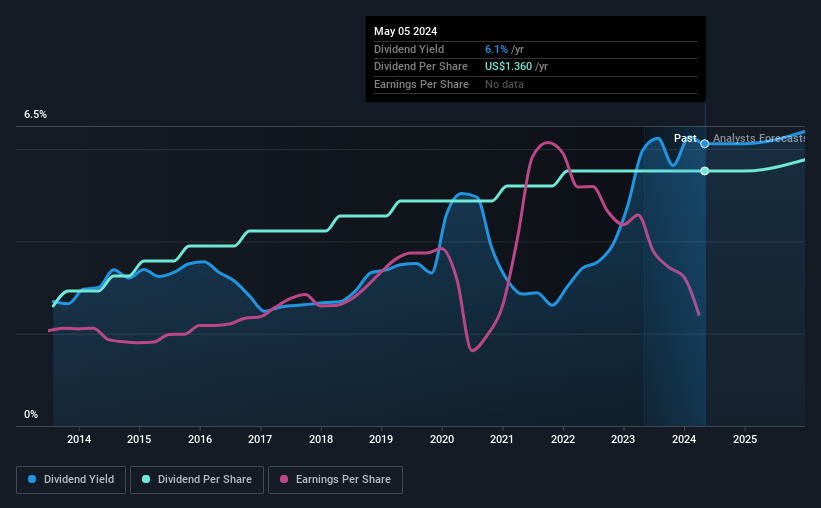Sandy Spring Bancorp, Inc. (NASDAQ:SASR) will pay a dividend of $0.34 on the 15th of May. The dividend yield will be 6.1% based on this payment which is still above the industry average.
See our latest analysis for Sandy Spring Bancorp
Sandy Spring Bancorp's Dividend Forecasted To Be Well Covered By Earnings
If the payments aren't sustainable, a high yield for a few years won't matter that much.
Having distributed dividends for at least 10 years, Sandy Spring Bancorp has a long history of paying out a part of its earnings to shareholders. Based on Sandy Spring Bancorp's last earnings report, the payout ratio is at a decent 66%, meaning that the company is able to pay out its dividend with a bit of room to spare.
Over the next year, EPS is forecast to expand by 17.2%. If the dividend continues on this path, the future payout ratio could be 61% by next year, which we think can be pretty sustainable going forward.

Sandy Spring Bancorp Has A Solid Track Record
Even over a long history of paying dividends, the company's distributions have been remarkably stable. Since 2014, the annual payment back then was $0.64, compared to the most recent full-year payment of $1.36. This works out to be a compound annual growth rate (CAGR) of approximately 7.8% a year over that time. Companies like this can be very valuable over the long term, if the decent rate of growth can be maintained.
Dividend Growth Is Doubtful
Investors who have held shares in the company for the past few years will be happy with the dividend income they have received. However, initial appearances might be deceiving. In the last five years, Sandy Spring Bancorp's earnings per share has shrunk at approximately 7.8% per annum. Declining earnings will inevitably lead to the company paying a lower dividend in line with lower profits. Earnings are predicted to grow over the next year, but we would remain cautious until a track record of earnings growth is established.
In Summary
In summary, we are pleased with the dividend remaining consistent, and we think there is a good chance of this continuing in the future. The earnings coverage is acceptable for now, but with earnings on the decline we would definitely keep an eye on the payout ratio. The payment isn't stellar, but it could make a decent addition to a dividend portfolio.
It's important to note that companies having a consistent dividend policy will generate greater investor confidence than those having an erratic one. At the same time, there are other factors our readers should be conscious of before pouring capital into a stock. Taking the debate a bit further, we've identified 1 warning sign for Sandy Spring Bancorp that investors need to be conscious of moving forward. Is Sandy Spring Bancorp not quite the opportunity you were looking for? Why not check out our selection of top dividend stocks.
New: Manage All Your Stock Portfolios in One Place
We've created the ultimate portfolio companion for stock investors, and it's free.
• Connect an unlimited number of Portfolios and see your total in one currency
• Be alerted to new Warning Signs or Risks via email or mobile
• Track the Fair Value of your stocks
Have feedback on this article? Concerned about the content? Get in touch with us directly. Alternatively, email editorial-team (at) simplywallst.com.
This article by Simply Wall St is general in nature. We provide commentary based on historical data and analyst forecasts only using an unbiased methodology and our articles are not intended to be financial advice. It does not constitute a recommendation to buy or sell any stock, and does not take account of your objectives, or your financial situation. We aim to bring you long-term focused analysis driven by fundamental data. Note that our analysis may not factor in the latest price-sensitive company announcements or qualitative material. Simply Wall St has no position in any stocks mentioned.
About NasdaqGS:SASR
Sandy Spring Bancorp
Operates as the bank holding company for Sandy Spring Bank that provides commercial and retail banking, mortgage, private banking, and trust services in the United States.
Flawless balance sheet established dividend payer.
Similar Companies
Market Insights
Community Narratives




